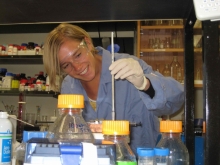
University:
Major:
Mentor(s):
Faculty Sponsor(s):
Faculty Sponsor's Department:
Project Title:
Project Description:
Hydration water plays a vital role in biological functions: it stabilizes biomolecular structures and mediates biophysical processes, such as protein folding. Previous studies have revealed that osmolytes (e.g. dimethylsulfoxide (DMSO)) or ions can alter the functions and structures of lipid membrane by modulating hydration properties of membranes. However, the role of hydration water in association with lipid membranes is still unclear. In this work, we study how DMSO modulates structure, dynamics and hydration of lipid membrane by various techniques. Multilamellar (MLV) and unilamellar vesicles (LUV) of phosphatidylcholine bilayers at variable DMSO concentrations were used as classic model systems. X-ray scattering measurement confirmed the previous observation that repeat distance of bilayers decreases at increasing DMSO concentration, regardless of lipid phases. 1H Overhauser Dynamic Nuclear Polarization spectroscopy enables quantification of local water diffusion on membrane surface. A previous study has shown that water diffusion on the surface of LUV sample increases at high DMSO concentration. Additionally, the activation energy of water diffusion on the membrane surface is decreased in presence of DMSO suggesting that DMSO reduces the energy barrier of hydration water diffusion. 31P NMR and Electron Paramagnetic Resonance line-shape analysis revealed that the lipid phosphate became ordered in the presence of DMSO. Furthermore, FTIR Spectroscopy indicated that DMSO assists the formation of hydrogen bonding between water and the carbonyl group of lipid membrane. Our results exhibit that DMSO modulates local hydration dynamics and structures at the membrane interfaces likely due to interaction or alternation of hydrogen bonding networks, or hydrophobic effect. This work serves as a foundation for future investigations of more complex membrane functions, such as membrane fusion or protein-membrane interactions.
